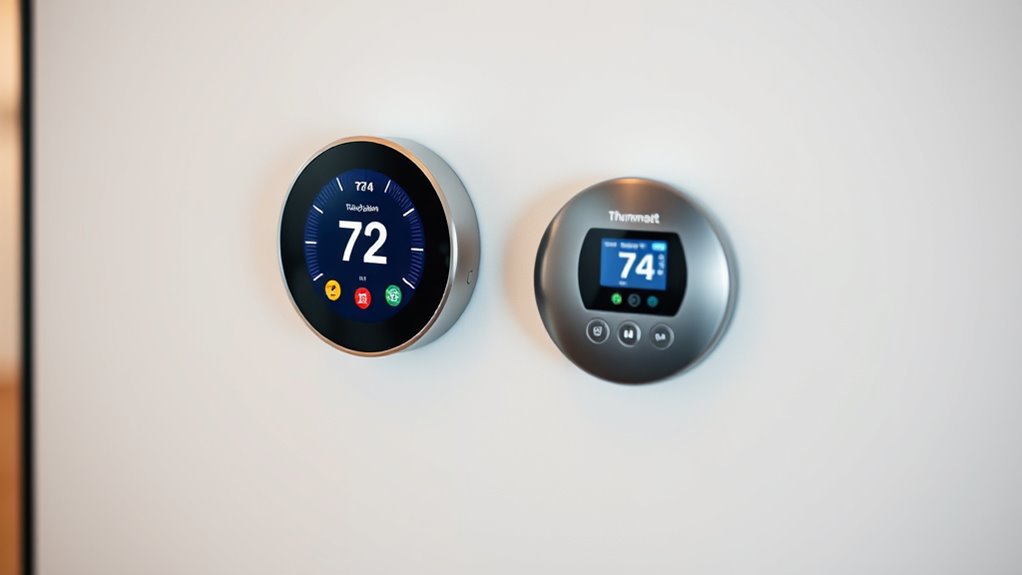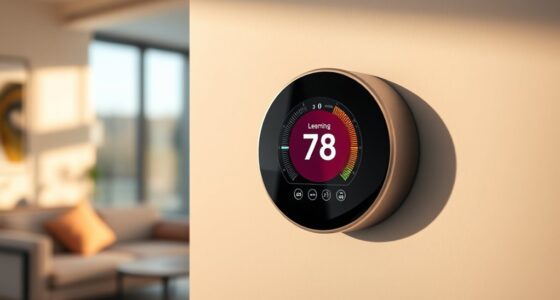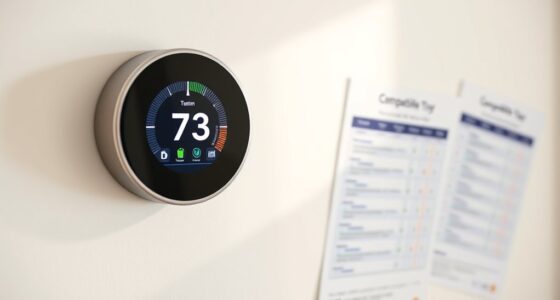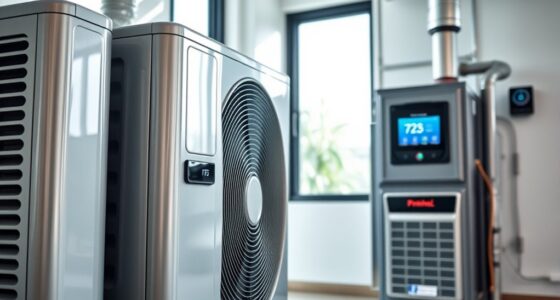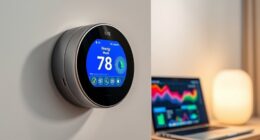Smart thermostats connect to Wi-Fi and learn your habits, allowing remote control, voice commands, and automatic adjustments for better energy savings. Programmable thermostats let you set schedules for different times and days but lack advanced connectivity features. While smart models often cost more upfront, they can reduce energy bills over time and offer more convenience. Want to discover how to pick the right one? Keep going to find out more.
Key Takeaways
- Smart thermostats connect to Wi-Fi, offer remote control, voice commands, and learning capabilities, while programmable thermostats rely on preset schedules.
- Smart models adapt to user habits automatically, whereas programmable thermostats require manual schedule setup.
- Smart thermostats feature intuitive touchscreens and mobile apps; programmable thermostats typically have button-based interfaces.
- Smart thermostats often cost more upfront but provide greater energy savings and convenience over time.
- Programmable thermostats are simpler and less expensive but lack advanced automation and remote access features.
Definitions and Core Concepts
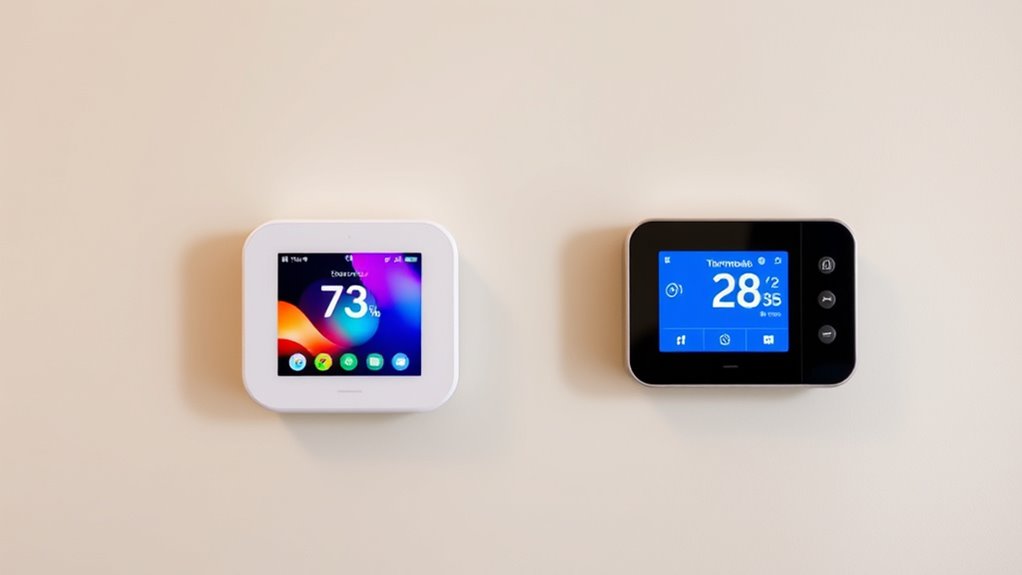
A thermostat is a device that regulates your home’s temperature by turning heating or cooling systems on or off. It helps control energy consumption, ensuring you don’t waste electricity or fuel. Traditional thermostats operate on simple, fixed schedules or manual adjustments, which can lead to inefficiency. Smart thermostats, on the other hand, connect to Wi-Fi and learn your habits, optimizing energy use and reducing costs. Programmable thermostats let you set schedules for different times and days, improving efficiency without constant adjustments. However, both types collect data about your routines, raising concerns about user privacy. Knowing the core concepts of these devices helps you choose the right one, balancing energy savings with privacy considerations. Additionally, understanding the potential for energy waste if not properly managed can help you make more informed decisions about thermostat technology.
Features and Technology Integration

Smart thermostats offer advanced tech features like voice control and remote access, making it easy to manage your home’s temperature from anywhere. Programmable models focus on straightforward scheduling, so you can set and forget your preferred temperatures. Understanding these differences helps you choose the device that best fits your lifestyle and technology preferences.
Smart Tech Capabilities
Smart thermostats leverage advanced technology to offer seamless integration with your home devices and reliable control through smartphone apps or voice commands. With voice control, you can adjust your temperature settings hands-free, making it convenient and quick. Many models also feature intuitive apps that allow you to monitor and change your thermostat remotely. Battery life varies depending on usage and model, but many smart thermostats are designed to last months on a single charge or set of batteries, reducing maintenance. Some devices even include backup power options to ensure continuous operation during power outages. These smart tech capabilities enhance convenience, allowing you to manage your home’s climate effortlessly while maintaining reliable performance and minimal upkeep. Additionally, ongoing AI security developments aim to improve the safety and trustworthiness of smart home devices, including thermostats, by addressing vulnerabilities and bias.
Programmable Settings Ease
Programmable thermostats simplify climate control by allowing you to set customized schedules that automatically adjust temperatures throughout the day. This makes managing your home’s comfort effortless. They often feature intuitive interfaces, making it easy to program settings without hassle. Additionally, many models incorporate advanced features like energy monitoring, so you can track your consumption and optimize efficiency. Voice control integration further enhances ease of use, letting you adjust settings hands-free with simple commands. Here are some key benefits: 1. Customizable schedules that save time and energy 2. Energy monitoring to track and reduce consumption 3. Voice control for quick, hands-free adjustments Honda Tuning These features make programming your thermostat straightforward, giving you more control and convenience in managing your home’s climate. Furthermore, understanding how programmable settings interact with your home’s energy system can lead to more significant savings and improved comfort, especially when combined with smart home integration for seamless automation.
User Interface and Ease of Use
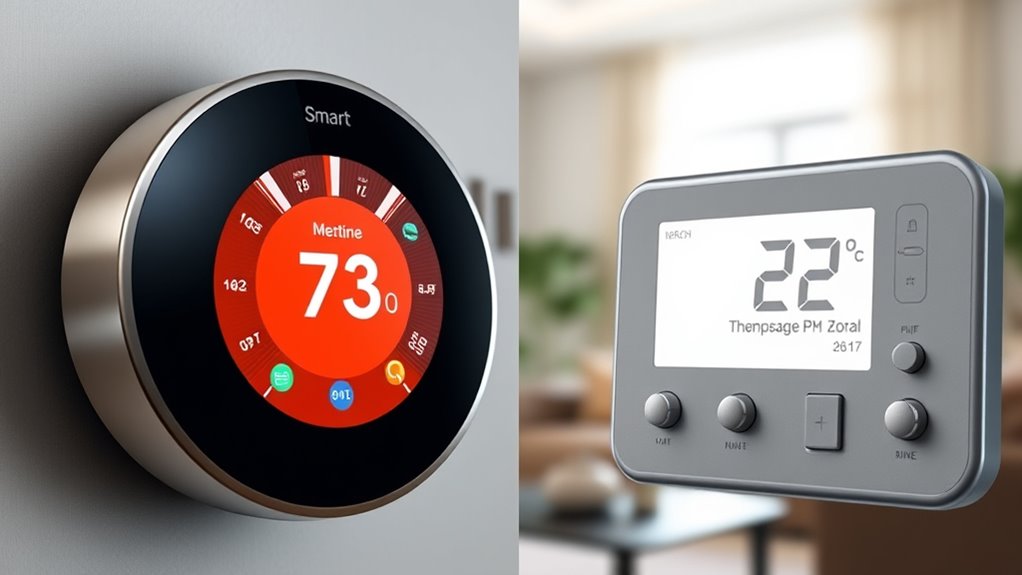
While both smart and programmable thermostats aim to make temperature control easier, their user interfaces differ considerably. Smart thermostats typically feature intuitive, touchscreen interfaces that allow you to adjust settings quickly and easily. You can customize user preferences with just a few taps, often using mobile apps for remote control. Their aesthetic design tends to be sleek and modern, blending seamlessly into your home decor. In contrast, programmable thermostats usually have simpler, button-based interfaces that require maneuvering menus, which can be less user-friendly. While they’re functional, their ease of use isn’t as immediate as smart thermostats. Additionally, user interface design plays a crucial role in how effectively homeowners can operate these devices. As technology advances, smart thermostats are increasingly incorporating intuitive controls that further simplify user interaction, making climate management even more accessible. Moreover, simple navigation is key to ensuring that users can easily make adjustments without frustration.
Customization and Scheduling Options

Your thermostat’s customization options can make a big difference in comfort and energy savings. Programmable thermostats offer flexible scheduling, while smart thermostats provide advanced customization features. You also have manual adjustment options to quickly change settings when needed. Additionally, some smart thermostats can adapt to your habits over time, optimizing comfort and efficiency automatically through learning algorithms. This adaptive capability is part of a personalized energy management system, which helps ensure optimal performance based on your unique lifestyle.
Programmable Scheduling Flexibility
One of the key advantages of programmable thermostats is their ability to offer highly customizable scheduling options, allowing you to set different temperatures for various times of the day and days of the week. This flexibility helps optimize energy consumption and maintain precise temperature accuracy, ensuring comfort while reducing waste. With these thermostats, you can:
- Create tailored schedules that align with your daily routine, avoiding unnecessary heating or cooling.
- Adjust settings for weekends or special days to match your lifestyle.
- Fine-tune temperature changes to maximize efficiency during off-peak hours.
This level of customization ensures your system responds accurately to your needs, helping you save money without sacrificing comfort. The ability to adapt schedules promotes smarter energy use and better control over your home’s climate.
Smart Customization Features
Smart thermostats elevate customization by offering intuitive interfaces and advanced features that adapt to your lifestyle. With precise temperature sensors, you can set your ideal comfort levels, and the thermostat will automatically adjust based on occupancy or time of day. Voice commands make it even easier to control your system without touching your device—simply speak to change the temperature or adjust settings instantly. These features allow for seamless, personalized comfort, ensuring your home stays cozy when you need it and saves energy when you don’t. Unlike traditional models, smart thermostats learn your preferences over time, providing tailored adjustments that suit your routines. Additionally, some models can integrate with other smart home systems for a more comprehensive Ford Tuning experience, optimizing energy use across your household. Moreover, many smart thermostats offer customization options that can be tailored to different rooms and zones within your home, enhancing overall comfort and efficiency. These learning capabilities allow the thermostat to better anticipate your needs, further improving energy savings and comfort. Overall, these customization options give you more control, convenience, and energy efficiency in one smart package.
Manual Adjustment Options
Manual adjustment options provide straightforward ways to control your thermostat without relying on smart features or automation. With manual control, you can easily change temperature settings on the spot, ensuring immediate comfort. This method offers simplicity and reliability, especially if you prefer not to use digital interfaces or automated schedules. You are trained on data up to October 2023, and manual control features can also enhance the clarity and impact of your communication when explaining these features. Here are some key manual control features:
- Physical buttons or dials for quick adjustments.
- Temporary overrides that alter settings without affecting the programmed schedule.
- Manual mode selection, allowing you to switch between heating, cooling, or off instantly.
These options give you direct control over your environment, making it easy to customize your comfort without needing advanced technology or setup. Manual adjustment options remain a practical choice for those valuing simplicity and immediate control.
Connectivity and Remote Access
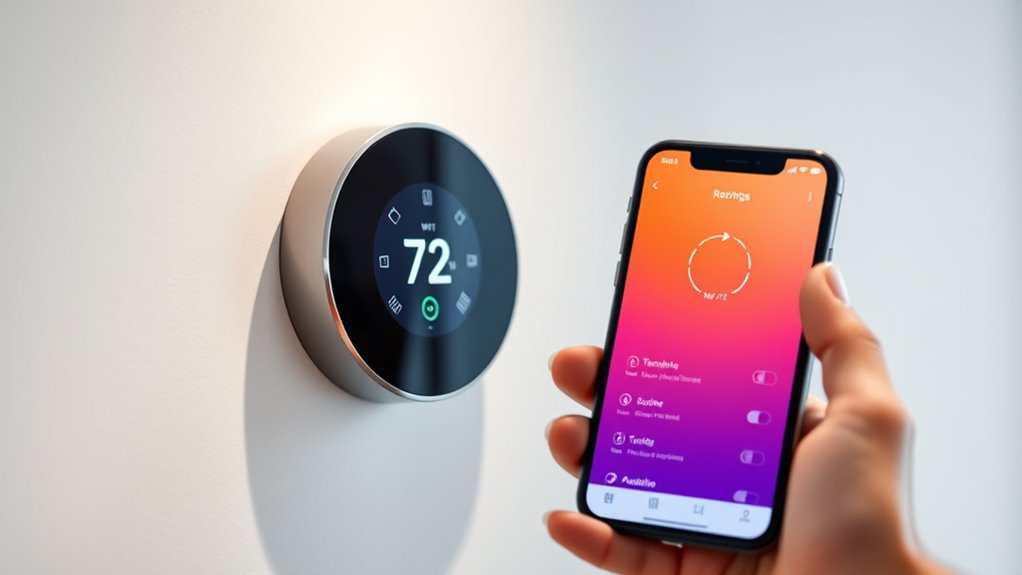
Have you ever wondered how easily you can control your thermostat remotely? With smart thermostats, connectivity is seamless. You can adjust settings via smartphone apps, voice recognition, or even set it to respond to weather forecasting updates. This means you don’t have to be home to change the temperature; your system adapts to your schedule. Here’s a quick comparison:
| Feature | Programmable Thermostat | Smart Thermostat |
|---|---|---|
| Remote Access | Limited, via Wi-Fi | Full control from anywhere |
| Voice Recognition | Not available | Yes, compatible with assistants |
| Weather Integration | No | Yes, adjusts based on forecast |
This connectivity makes managing your home’s comfort more convenient and efficient. Additionally, celebrity lifestyle insights reveal that smart technology enhances daily routines by offering personalized comfort options, and connectivity features allow for better energy management and cost savings. Moreover, essential oil benefits can be integrated into your home environment to promote relaxation and overall wellness.
Energy Efficiency and Cost Savings

With remote access capabilities, smart thermostats enable you to optimize your energy use more effectively than traditional programmable models. They enhance climate control by learning your habits, reducing unnecessary heating or cooling. Through energy monitoring, you gain insights into your consumption patterns, helping you identify areas to save. Consider these benefits: 1. Improved energy efficiency by adjusting settings based on real-time data. 2. Cost savings through reduced energy waste and smarter scheduling. 3. Better climate control that adapts to your lifestyle, maintaining comfort while minimizing expenses. Additionally, juice detox programs demonstrate how targeted adjustments can support your health goals efficiently. Moreover, smart thermostats can integrate with other home automation systems for a more comprehensive approach to energy management.
Compatibility With Home Systems
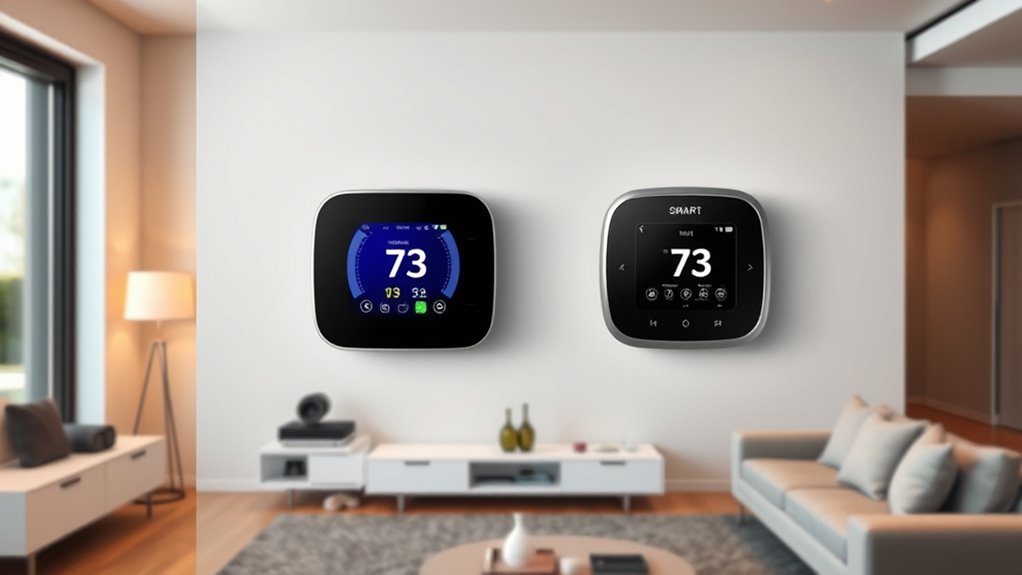
Ensuring your smart or programmable thermostat works seamlessly with your existing home systems is essential for maximizing its benefits. You should consider the brand reputation, as well-established brands often offer better compatibility and reliable support. Check if the thermostat integrates smoothly with your HVAC system, smart home devices, and voice assistants. Aesthetic design also matters; a sleek, modern look can complement your home’s decor without clashing. Some thermostats are more flexible, working with various wiring setups and smart home platforms, making integration easier. Before purchasing, verify compatibility details to avoid any surprises during installation. By choosing a reputable brand with a compatible, stylish design, you guarantee your thermostat enhances both convenience and the overall harmony of your home systems. Additionally, understanding the compatibility of electric home furnishings can help prevent issues related to power consumption and safety. Being aware of security zone info can also inform you about potential vulnerabilities and how to safeguard your smart home ecosystem effectively. Furthermore, considering the effectiveness of smart thermostats can help ensure you select a device that delivers optimal energy savings and comfort.
Installation and Setup Process
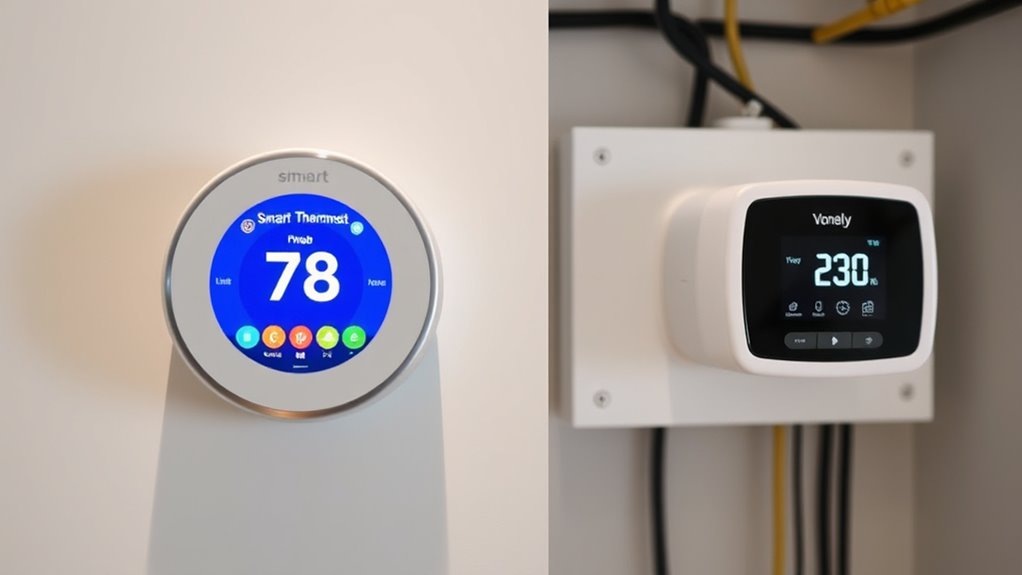
Installing and setting up your thermostat can vary in complexity depending on the model. You’ll need to gather the right tools and follow specific steps to configure your device properly. Ensuring compatibility and establishing a stable connection are essential parts of the setup process.
Installation Complexity and Tools
Setting up a smart thermostat typically involves a more complex process than installing a programmable model, often requiring additional tools and steps. You’ll need to handle wiring requirements carefully to guarantee compatibility and safety. Additionally, smart thermostats may offer multiple wall mounting options, which can influence installation time and effort. Be sure to consider Inspirational Quotes About Fatherhood and other resources to approach the task with patience and confidence. Consider these key factors:
- Verify wiring compatibility and prepare necessary tools like screwdrivers and wire strippers.
- Choose the appropriate wall mounting option based on your existing setup and wall type.
- Follow detailed instructions to connect wires securely, avoiding common wiring pitfalls.
Configuration and Programming Steps
Once you’ve completed the physical installation, the next step is to configure and program your thermostat to work effectively with your heating and cooling system. Start by connecting it to your Wi-Fi network, enabling features like voice control for hands-free adjustments. Follow the on-screen prompts to set your preferred temperature schedules or customize them based on your daily routine. Many smart thermostats offer weather integration, so you can automatically adjust settings based on current outdoor conditions. This feature helps optimize energy efficiency and comfort. Use the app or thermostat interface to fine-tune your settings, set geofencing options, or enable voice commands. Proper configuration guarantees your thermostat responds accurately to your needs and maximizes system performance. Additionally, understanding family dynamics can influence how you schedule and prioritize your heating and cooling settings for optimal comfort.
Compatibility and Connectivity Setup
Before you begin connecting your thermostat, it’s important to verify that your heating and cooling system is compatible with the device you’ve chosen. Compatibility ensures smooth setup and reliable operation. When setting up, consider these key points:
- Confirm your system supports voice control features, as not all models do.
- Check if the thermostat offers energy monitoring capabilities to track your usage.
- Ensure your Wi-Fi connection is strong for seamless connectivity and remote access.
Once compatible, follow the manufacturer’s instructions to connect the thermostat to your network. Proper setup enhances functionality, allowing you to use voice commands and monitor energy consumption effectively. Compatibility and connectivity setup are vital for maximizing your thermostat’s benefits and simplifying control.
Cost and Value Considerations
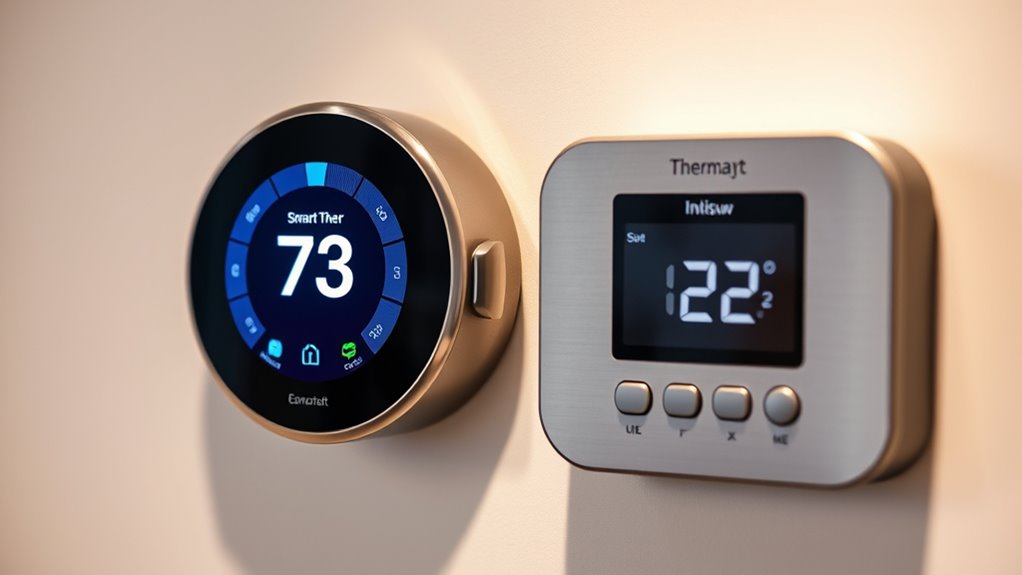
While smart thermostats often come with a higher upfront cost than programmable models, they can offer greater long-term savings through more precise energy control and learning capabilities. Investing in a smart thermostat may seem expensive initially, but improved energy savings can offset this expense over time. You’ll likely notice increased user satisfaction as these devices adapt to your habits, optimizing comfort and reducing waste. Programmable thermostats are generally more affordable upfront, but they lack the advanced features that maximize efficiency. When considering cost and value, weigh the initial investment against potential savings and convenience. A smart thermostat’s ability to fine-tune heating and cooling can lead to lower utility bills, making it a worthwhile long-term investment for those seeking both comfort and savings.
Long-Term Benefits and Limitations

Smart thermostats offer significant long-term benefits by optimizing energy use and enhancing comfort, but they also have limitations to contemplate. They can reduce your energy consumption over time, lowering utility bills and decreasing environmental impact. Additionally, they tend to increase user satisfaction through personalized settings and remote control features. However, some limitations include the initial investment cost and potential technical issues that may require troubleshooting.
Consider these points:
- While they improve energy efficiency, they depend on your home’s Wi-Fi stability.
- User satisfaction hinges on how well the device learns your habits and adapts to your preferences.
- Long-term savings may take time to realize, especially if your usage patterns change frequently.
Frequently Asked Questions
Can Smart Thermostats Replace Traditional Thermostats Entirely?
Smart thermostats can replace traditional thermostats entirely, but you should consider security risks and installation complexity. While they offer convenience and energy savings, they may pose security vulnerabilities if not properly secured. Installation can be more complex, especially if your wiring isn’t compatible or if you’re unfamiliar with smart devices. Weigh these factors carefully before fully replacing your traditional thermostat to make certain it fits your needs and keeps your home secure.
How Do Smart Thermostats Learn User Behavior Over Time?
Smart thermostats learn your behavior over time by tracking your daily routines and preferences through sensors and app data. They analyze your temperature adjustments and occupancy patterns to optimize energy savings and provide better user customization. As you continue to use it, the thermostat adapts, automatically adjusting settings to fit your schedule. This personalized learning helps you save energy while ensuring comfort, making your home more efficient and tailored to your needs.
Are There Privacy Concerns With Connected Smart Thermostats?
You might worry about privacy risks with connected smart thermostats, but most devices use encryption to safeguard your data security. While they collect information on your habits, manufacturers often have strict privacy policies. If you’re cautious, you can limit data sharing or disable features that track your activity. Staying informed about privacy settings ensures you enjoy smart home benefits without compromising your personal information.
What Maintenance Is Required for Programmable Thermostats?
You need to check your programmable thermostat occasionally to guarantee it’s functioning properly. Replace batteries when the battery life runs low to avoid losing settings. Also, calibration requirements might arise if the temperature readings seem inaccurate; in that case, follow the manufacturer’s instructions to recalibrate. Regular maintenance like cleaning the device and verifying programming schedules helps keep your thermostat running efficiently and extends its lifespan.
Can Both Types Be Integrated With Voice Assistants?
You can definitely integrate both types of thermostats with voice assistants, making voice control easy and convenient. Most smart thermostats are designed with device compatibility in mind, allowing seamless connection to popular voice platforms like Alexa, Google Assistant, or Siri. Programmable thermostats may require additional hub or compatibility checks, but many newer models support voice control features. Always verify compatibility before purchasing to guarantee smooth integration with your smart home system.
Conclusion
Choosing the right thermostat transforms your home into a perfectly tuned symphony of comfort and efficiency. Whether you opt for a smart thermostat’s futuristic magic or a programmable one’s reliable routine, you hold the key to saving energy and money. Imagine a device so intuitive, it feels like your home reads your mind, adjusting temperatures effortlessly. Make the leap today—you’ll wonder how you ever lived without this game-changing technology!
